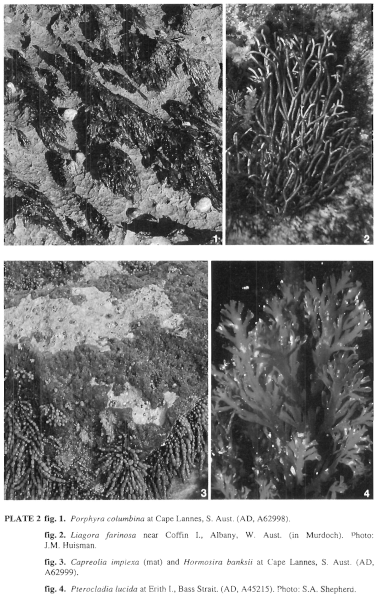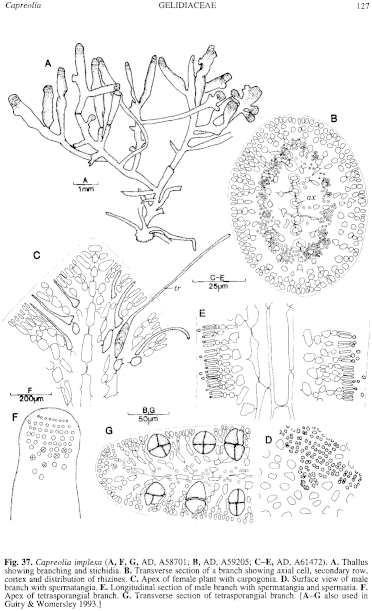|
|
|
|
|
|||||||||||
|
Electronic Flora of South Australia Species Fact Sheet
Phylum Rhodophyta – Class Florideophyceae – Order Gelidiales – Family Gelidiaceae
Thallus (Fig. 37A) brown to dark red-brown, forming thin to compact entangled mats, 1–3 (–5) mm thick and usually 1–10 cm in spread, with prostrate stolons bearing semi-erect to repent, irregularly branched, branches; epilithic or on mussels or limpets in the mid eulittoral on rough-water to sheltered coasts. Stolons terete, 200–400 µm in diameter, main branches usually 3–6 (–10) mm long, arising irregularly from the upper side of the stolons, irregularly branched, terete to compressed (Fig. 37B) and 150–350 (–500) µm broad, sometimes with subdistichous branches near their ends; lesser branches terete to compressed, 100–150 µm in diameter, tapering gradually to a protruding apical cell; distinct erect axes absent. Holdfasts of massed rhizoids (often terminating short branches) 250–600 µm across, from the lower sides of the stolons and commonly opposite an "erect" branch; epilithic or on Avicennia. Structure. Outer cortical cells rounded in surface view, protoplast 4–6 µm across, wall thick; medulla of a network of elongate cells, some almost rhizoidal; rhizines few to abundant, mainly in the outer medulla (Fig. 37B).
Reproduction: Female plants known only in culture, 5–20 mm across, much branched, with carpogonia (Fig. 37C) intercalary and the zygote developing stellate protuberances on the female thallus which develop directly into tetrasporophytes. Male thalli 5–20 mm across, much branched, with surface sori (Fig. 37D) of elongate spermatangial initials 1.5–2.5 µm in diameter (Fig. 37E), cutting off spermatangia terminally.
Stichidia (Fig. 37A,F) on terminal or lateral branchlets, compressed, shortly stipitate, apices rounded, (0.5–) 1–2.5 mm long, 250–1000 µm across. Tetrasporangia in regular, acropetally developed rows ("chevron-like"), lying in two layers (Fig. 37G) in the outer medulla, with all sporangia in a row of similar age and few (if any) of varying age, ovoid, (20–) 25–45 µm in diameter, regularly or irregularly decussately or cruciately divided.
Type from Sandringham, Port Phillip, Vic., near high tide, shaded (Guiry, 14.v.1988; holotype in MELU, A37758; isotype in AD, A58701).
Selected specimens: Wittelbee Point, Ceduna, S. Aust., lower eulittoral (Womersley, 22.i.1951; AD, A15060). Venus Bay, S. Aust., mid eulittoral, shaded (Womersley, 17.i.1951; AD, A14950). Port Lincoln, S. Aust., upper sublittoral on tidal flats near town (Womersley, 23.ii.1959; AD, A22571). Opposite Bird Is, 10 km SW of Wallaroo, S. Aust., mid eulittoral on Avicennia pneumatophores, shaded (Womersley, 23.xi.1991; AD, A61505 -"Marine Algae of southern Australia" No. 339a). Barker Rocks, Yorke Pen., S. Aust., mid eulittoral (Womersley, 17.x.1989; AD, A59909 -"Marine Algae of southern Australia" No. 339). Edithburg, S.Aust., mid eulittoral (Prud'homme van Reine & Womersley, 14.x.1988; AD, A59205). Aldinga, S. Aust., mid eulittoral (Womersley, 17.vii.1988; AD, A58711). Rocky Point, Kangaroo I., S. Aust., upper eulittoral (Womersley, 23.i.1947; AD, A46403). Shag Rock, American R. inlet, Kangaroo I., S. Aust., upper eulittoral (Womersley, 6.ix.1946; AD, A4143). Cape Willoughby, Kangaroo I., S. Aust., upper sublittoral (Womersley, 16.i.1946; AD, A4227). Robe, S. Aust., mid eulittoral (Guiry, 4.vii.1988; AD, A58704). Lorne, Vic., mid eulittoral (Womersley, 23.v.1988; AD, A58696). Cape Lannes, S. Aust., lower to mid eulittoral (Womersley, 17.ix.1993; AD, A62999). Point Lonsdale, Vic., mid eulittoral (Womersley, 23.v.1988; AD, A58694). Blairgowrie, Vic., upper eulittoral, "back beach" (Guiry, culture 701, 1.v.1988; AD, A61472). Walkerville, Vic., mid eulittoral (Bennett, 10.xi.1949; AD, A15242). Cape Sorel!, Tas., mid eulittoral (Bennett, 4.ii.1955; AD, A20599). Bicheno, Tas., mid eulittoral (Bennett, 6.ii.1955; AD, A20667). Dover, Tas., lower eulittoral (Wollaston & Mitchell, 27.ii.1964; AD, A27720). Long Reef, Collaroy, N.S.W. (Philson & Earle, 23.xii.1934; Tilden, "South Pacific Plants" Ser.2, No. 273; AD, A49886). Pearl Beach, Broken Bay, N.S.W., mid eulittoral (Pope, Aug. 1950; AD, A15275).
Distribution: New Zealand.
Wittelbee Point, S. Aust., to Broken Bay, N.S.W., and around Tasmania.
Taxonomic notes: Capreolia implexa is the common mat-forming, usually mid eulittoral, gelidioid species on south-eastern Australian coasts, and most records (e.g. Fuhrer et al. 1981: pls 55, 56; May 1949b, p. 198) of Gelidium pusillum at this intertidal level are likely to apply to C. implexa. It occurs on both rough-water and sheltered coasts, usually in slightly to moderately shaded areas, and often on mussels or Galeolaria.
Capreolia implexa is distinctive in its mat-like habit of entangled branches, with few if any becoming erect, and in the regular rows of tetrasporangia of similar age developing from the branch apices backwards. In young sori of rough-water plants the rows are particularly regular, but in older sori and in calm-water plants the rows are less regular and some younger sporangia appear adjacent to older ones in the sori. Pterocladia melanoidea (Schousboe ex Bornet) Dawson 1962: 38; Fredriksen & Rueness 1990, p. 182, fig. 4, also has tetrasporangia in regular rows but has very few rhizines.
References:
DAWSON, E.Y. (1962). Additions to the marine flora of Costa Rica and Nicaragua. Pac. Naturalist 3, 375–395.
FREDRIKSEN, S. & RUENESS, J. (1990). Culture studies on Pterocladia melanoidea (Schousboe ex Bornet) comb. nov. (Gélidiales, Rhodophyta). Phycologia 29, 182–190.
FUHRER, B., CHRISTIANSON, I.G., CLAYTON, M.N. & ALLENDER, B.M. (1981). Seaweeds of Australia. (Reed: Sydney.)
GUIRY, M.D. & WOMERSLEY, H.B.S. (1993). Capreolia implexa gen. et sp. nov. in Australia and New Zealand (Gélidiales, Rhodophyta); an intertidal red alga with an unusual life history. Phycologia 32, 266–277.
MAY, V. (1949b). Studies on Australian marine algae. V. Observations on and geographical records of various species, particularly those of the Gelidium complex. Proc. Linn. Soc. N.S.W. 74, 196–202.
The Marine Benthic Flora of Southern Australia Part IIIA complete list of references.
Publication:
Womersley, H.B.S. (14 January, 1994)
The Marine Benthic Flora of Southern Australia
Rhodophyta. Part IIIA, Bangiophyceae and Florideophyceae (to Gigartinales)
Reproduced with permission from The Marine Benthic Flora of Southern Australia Part IIIA 1994, by H.B.S. Womersley. Australian Biological Resources Study, Canberra. Copyright Commonwealth of Australia.
Illustrations in Womersley Part IIIA, 1994: PLATE 2 fig. 3; FIG. 37.

Plate 2 enlarge
PLATE 2 fig. 1. Porphyra columbina at Cape Lannes, S. Aust. (AD, A62998). fig. 2. Liagora farinosa near Coffin I., Albany, W. Aust. (in Murdoch). Photo: J.M. Huisman. fig. 3. Capreolia implexa (mat) and Hormosira banksii at Cape Lannes, S. Aust. (AD, A62999). fig. 4. Pterocladia lucida at Erith I., Bass Strait. (AD, A45215). Photo: S.A. Shepherd.

Figure 37 enlarge
Fig. 37. Capreolia implexa (A, F, G, AD, A58701; B, AD, A59205; C–E, AD, A61472). A. Thallus showing branching and stichidia. B. Transverse section of a branch showing axial cell, secondary row, cortex and distribution of rhizines. C. Apex of female plant with carpogonia. D. Surface view of male branch with spermatangia. E. Longitudinal section of male branch with spermatangia and spermatia. F. Apex of tetrasporangial branch. G. Transverse section of tetrasporangial branch. [A–G also used in Guiry & Womersley 1993.]

|
Email Contact: State Herbarium of South Australia |

|